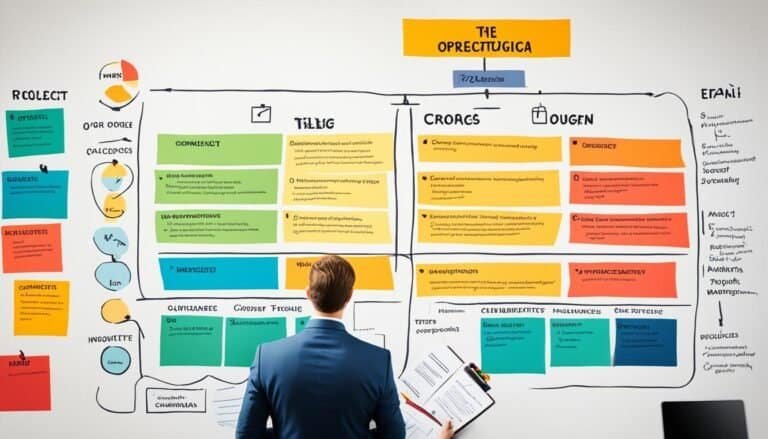Procurement Management: Securing the Right Resources for Your Project
Procurement management is a critical aspect of project success, ensuring that the right resources are secured to meet project requirements. From defining project resources to evaluating supplier options, effective procurement management plays a significant role in maximizing value and ensuring quality control.
However, navigating the procurement process can be complex and challenging. In this discussion, we will explore the important steps involved in procurement management, highlighting key strategies for identifying project requirements, developing a procurement plan, and managing supplier relationships.
By understanding these essential elements, project managers can optimize their procurement practices and secure the right resources for their projects, ultimately leading to successful outcomes.
Key Takeaways
- Procurement management is crucial for successful project execution and securing necessary resources.
- Strategic sourcing helps minimize risks and maximize value in procurement.
- Supplier evaluation is important for selecting suppliers that align with project objectives.
- Considering cost and availability is essential in defining and identifying project resources.
The Importance of Procurement Management
Procurement management plays a crucial role in ensuring the successful execution of projects by effectively securing the necessary resources. The role of procurement management in project success cannot be overstated. It involves strategic sourcing and supplier evaluation to ensure that the right resources are obtained at the right time and cost.
Strategic sourcing is an essential component of procurement management. It involves identifying the best sources for the required goods or services. This process requires careful consideration of factors such as quality, cost, reliability, and delivery timelines. By strategically sourcing the required resources, procurement managers can minimize risks and maximize value for the project.
Supplier evaluation is another critical aspect of procurement management. It involves assessing potential suppliers based on various criteria, such as their financial stability, reputation, and ability to meet project requirements. By thoroughly evaluating suppliers, procurement managers can select those that best align with the project’s objectives and deliverables.
Utilizing a vendor management system can streamline the supplier evaluation process, ensuring that procurement managers maintain organized, efficient, and reliable supplier relationships.
Implementing top purchasing software solutions can further enhance this process by automating evaluations, tracking supplier performance metrics, and providing data-driven insights for better decision-making.
Effective procurement management ensures that the project has access to the necessary resources in a timely manner. It helps minimize delays, cost overruns, and quality issues.
A thorough procurement analysis can help businesses optimize their purchasing strategies, identify cost-saving opportunities, and improve supplier relationships to enhance overall efficiency and project success.
By securing the right resources through strategic sourcing and supplier evaluation, procurement management significantly contributes to the overall success of a project.
Defining Project Resources
When it comes to defining project resources, there are three key points to consider.
First, understanding the different types of resources that will be needed for the project, such as personnel, equipment, and materials.
Second, establishing an efficient allocation process to ensure that resources are assigned to the right tasks and in the right quantities.
Lastly, considering the cost and availability of resources, as this will impact the project’s budget and timeline.
Resource Types
Differentiating and categorizing project resources is essential for effective procurement management and ensuring the right resources are secured for a project. Resource types can vary depending on the nature of the project and the specific requirements. It is important to identify and classify resources to develop appropriate procurement strategies.
To illustrate the different types of resources, consider the following table:
| Resource Type | Description |
|---|---|
| Human Resources | The individuals or teams with the necessary skills and expertise to perform project tasks. |
| Physical Resources | The tangible assets such as equipment, machinery, and facilities required for project execution. |
| Financial Resources | The funds and budget allocated for the project. |
| Material Resources | The raw materials, supplies, and components needed for project deliverables. |
| Information Resources | The data, knowledge, and information sources that support project activities. |
Allocation Process
The allocation process in procurement management involves defining project resources in a concise and organized manner. Resource allocation is a critical step in ensuring that the right resources are assigned to the right tasks at the right time.
Strategic sourcing is an essential aspect of the allocation process, as it involves identifying and selecting suppliers who can provide the necessary resources to meet project requirements. To effectively allocate resources, project managers need to consider various factors such as the availability of resources, their skills and expertise, and the project timeline.
Additionally, it is crucial to establish clear communication channels and document the allocation process to ensure transparency and accountability.
Cost and Availability
In order to effectively define project resources for the allocation process in procurement management, one must carefully consider the cost and availability of these resources.
Conducting a cost analysis is crucial to determine the financial implications of acquiring and utilizing specific resources. This analysis involves evaluating the direct and indirect costs associated with each resource, such as purchase costs, maintenance costs, and any additional expenses required for their integration into the project.
Furthermore, it is essential to assess the availability of resources to ensure they can be obtained within the desired timeframe. This involves considering factors such as lead times, supplier reliability, and any potential constraints that may impact resource availability.
Identifying Project Requirements
To effectively manage procurement, it is crucial to accurately identify and outline the specific requirements of the project. This involves understanding the project specifications and conducting a thorough resource identification process.
Here are four key steps to consider when identifying project requirements:
- Define the scope: Clearly define the project scope and objectives to establish what needs to be achieved. This will help determine the resources required to meet the project’s goals.
- Conduct stakeholder analysis: Identify the key stakeholders involved in the project and their roles and responsibilities. Understanding their needs and expectations will help determine the resources necessary to meet their requirements.
- Analyze project deliverables: Break down the project into specific tasks and deliverables. This will help identify the resources needed for each phase of the project and ensure that all requirements are met.
- Consider constraints and risks: Identify any constraints or risks that may impact the availability of resources. This could include budget limitations, time constraints, or potential resource shortages. By considering these factors, you can better plan for any potential challenges and ensure that the right resources are secured for the project.
Developing a Procurement Plan
After accurately identifying project requirements, the next step in effective procurement management is developing a comprehensive procurement plan. This plan outlines the strategy and processes for acquiring the necessary resources, products, or services needed to successfully complete the project. Developing a procurement strategy involves considering factors such as budget constraints, project timelines, and quality requirements.
One important aspect of the procurement plan is the supplier evaluation process. This process involves evaluating potential suppliers based on their capabilities, experience, and track record. It is essential to select suppliers who can meet the project’s specific needs and deliver high-quality products or services within the required timeframe.
To provide a visual representation of the procurement plan, a table can be used to organize the information. The table below outlines the key components of a procurement plan:
| Component | Description |
|---|---|
| Procurement Objectives | Clearly define the goals and objectives of the procurement process. |
| Procurement Strategy | Outline the approach for acquiring the necessary resources or services. |
| Supplier Evaluation Process | Detail the steps involved in evaluating and selecting potential suppliers. |
Evaluating Supplier Options
When evaluating supplier options for procurement management, it is crucial to carefully assess their capabilities, track record, and experience to ensure they can meet the project’s specific needs and deliver high-quality products or services within the required timeframe. Evaluating supplier performance and conducting a supplier risk assessment are essential steps in this process. Here are some key factors to consider:
- Quality and Reliability: Evaluate the supplier’s past performance to determine their ability to consistently deliver products or services of the desired quality. Look for certifications, references, and customer feedback to gauge their reliability.
- Capacity and Scalability: Assess the supplier’s capacity to handle the project’s requirements. Consider factors such as production capabilities, workforce size, and available resources. Additionally, consider whether the supplier has the flexibility to scale up or down if the project scope changes.
- Financial Stability: Conduct a thorough financial analysis of the supplier’s stability and viability. This includes reviewing their financial statements, credit ratings, and any potential risks that may impact their ability to fulfill contractual obligations.
- Supply Chain Management: Evaluate the supplier’s supply chain management practices to ensure they have robust processes in place. This includes assessing their supplier relationships, inventory management, and contingency plans for potential disruptions.
Negotiating Contracts and Agreements
Effective negotiation of contracts and agreements is a critical aspect of procurement management, ensuring that all parties involved are aligned on terms, conditions, and expectations. Contract negotiation involves the process of discussing and reaching an agreement on the terms and conditions that will govern the relationship between the buyer and the supplier. It is essential to establish clear and mutually beneficial agreement terms to minimize risks and maximize value.
During contract negotiation, it is important to consider various factors, such as pricing, delivery schedules, quality requirements, and performance metrics. Both parties should have a clear understanding of their rights and obligations, including payment terms, warranties, and dispute resolution mechanisms. Negotiations should also address any potential risks, such as force majeure events or changes in scope, to ensure that the agreement is comprehensive and robust.
To achieve successful contract negotiation, preparation is key. Both parties should thoroughly review the contract terms, identify potential issues, and come prepared with alternative solutions. It is crucial to maintain open and honest communication throughout the negotiation process, allowing for constructive dialogue and compromise.
Managing Supplier Relationships
To effectively manage supplier relationships, it is crucial for procurement professionals to establish clear lines of communication and foster collaborative partnerships. This ensures that both parties are aligned in terms of expectations, goals, and deliverables.
Managing supplier relationships involves various activities, including supplier performance monitoring and evaluation. Here are some key aspects to consider:
- Supplier performance: Regularly assess and monitor the performance of your suppliers to ensure they are meeting the agreed-upon standards. This can include evaluating their ability to deliver on time, the quality of their products or services, and their responsiveness to issues or concerns.
- Supplier evaluation: Implement a structured evaluation process to objectively assess your suppliers. This can involve conducting supplier audits, gathering feedback from internal stakeholders, and considering key performance indicators. By evaluating suppliers, you can identify areas for improvement and make informed decisions about future partnerships.
- Continuous improvement: Foster a culture of continuous improvement with your suppliers by providing feedback, sharing best practices, and collaborating on joint initiatives. By working together to identify and implement improvements, you can enhance the overall performance and value derived from the supplier relationship.
- Relationship management: Maintain regular communication with your suppliers and proactively address any issues or concerns that may arise. Building strong relationships based on trust and open dialogue is essential for long-term success.
Ensuring Quality Control
When it comes to ensuring quality control in procurement management, two important points to consider are the effectiveness of the inspection process and the implementation of quality assurance measures.
The inspection process should be well-designed and executed to detect any potential defects or non-compliance with specifications.
Additionally, quality assurance measures such as regular audits, performance evaluations, and supplier certifications can help maintain high standards and mitigate risks associated with poor quality resources.
Inspection Process Effectiveness
The inspection process plays a crucial role in ensuring the quality control of procurement management projects. To ensure the effectiveness of the inspection process, organizations can focus on inspection process improvement and the use of quality control metrics.
Here are some key considerations:
- Continuous Improvement: Organizations should regularly assess and improve their inspection processes to identify any inefficiencies or areas for enhancement.
- Adequate Training: Inspectors must receive proper training to ensure they possess the necessary skills and knowledge to perform their tasks effectively.
- Clear Standards and Criteria: Defining clear inspection standards and criteria helps maintain consistency and accuracy in the inspection process.
- Regular Monitoring and Evaluation: Regularly monitoring and evaluating the inspection process enables organizations to identify any deviations or issues and take corrective actions promptly.
Quality Assurance Measures
Implementing robust quality assurance measures is essential for ensuring effective quality control in procurement management projects.
These measures involve setting and adhering to specific quality standards and performance metrics.
Quality standards establish the criteria that products or services must meet in order to be deemed acceptable. They provide a framework for evaluating the quality of deliverables and ensuring that they meet the desired level of performance.
Performance metrics, on the other hand, provide quantitative measures of the quality of the procurement process. These metrics can include indicators such as on-time delivery, defect rates, customer satisfaction, and compliance with regulations.
Monitoring and Controlling Procurement Process
Effective monitoring and controlling of the procurement process is crucial for ensuring the successful acquisition of the right resources for your project. By closely monitoring progress and implementing effective control measures, project managers can identify and address any potential issues or deviations from the planned procurement process.
Here are some key aspects to consider when monitoring and controlling the procurement process:
- Regular progress updates: Establish a system for regular reporting and updates on the procurement process. This will allow project managers to track the progress of procurement activities and ensure that they are on schedule.
- Performance evaluation: Evaluate the performance of suppliers and contractors throughout the procurement process. This evaluation should assess their ability to meet quality standards, adhere to timelines, and provide the required resources.
- Risk management: Identify and mitigate potential risks that may arise during procurement. This includes assessing the financial stability of suppliers, ensuring compliance with legal and regulatory requirements, and implementing contingency plans.
- Change management: Monitor any changes that occur during the procurement process and assess their impact on the project. This includes changes in scope, budget, or timeline, and ensuring that appropriate measures are taken to manage these changes effectively.
Maximizing Value Through Effective Procurement Management
Maximizing value through effective procurement management involves implementing cost-effective procurement strategies, carefully selecting suppliers based on specific criteria, and successfully negotiating and managing contracts.
By adopting a strategic approach to procurement, organizations can optimize their purchasing decisions, minimize costs, and enhance overall value for their projects.
This requires a thorough understanding of the market, strong negotiation skills, and the ability to effectively manage supplier relationships and contracts throughout the procurement process.
Cost-Effective Procurement Strategies
To optimize the value of procurement management, organizations must employ cost-efficient strategies that prioritize resource allocation and maximize return on investment. Implementing cost saving measures is essential in achieving this goal.
Here are four key strategies to consider:
- Conduct thorough supplier evaluations to ensure quality and cost competitiveness.
- Implement strategic sourcing practices to identify the most cost-effective suppliers and negotiate favorable terms.
- Utilize economies of scale by consolidating purchasing across multiple projects or departments.
- Leverage technology and automation to streamline procurement processes and reduce administrative costs.
Supplier Selection Criteria
Selecting the right suppliers is a critical component of effective procurement management, as it directly impacts the value and success of a project. Supplier evaluation is a crucial step in this process, as it helps to ensure that the chosen suppliers can meet the project’s requirements and deliver high-quality products or services. When evaluating suppliers, several criteria should be considered, including supplier performance, reliability, financial stability, and ability to meet deadlines. A well-designed supplier selection process includes assessing the supplier’s track record, conducting site visits to verify their capabilities, and reviewing customer feedback and references. By thoroughly evaluating suppliers based on these criteria, project managers can make informed decisions and choose suppliers that will contribute to the overall success of the project.
| Criteria | Description | Importance |
|---|---|---|
| Supplier performance | Assessing the supplier’s past performance and track record, including their ability to deliver on time, quality of products or services, and customer satisfaction. | High |
| Reliability | Evaluating the supplier’s dependability and ability to meet deadlines consistently. | Medium |
| Financial stability | Assessing the supplier’s financial health and stability to ensure they can support the project’s requirements throughout its duration. | Medium |
| Ability to meet deadlines | Evaluating the supplier’s track record in meeting project deadlines and their ability to work within the project’s timeline. | High |
| Customer feedback and references | Reviewing the supplier’s reputation and references from previous clients to gauge their level of customer satisfaction and reliability. | Medium |
Negotiation and Contract Management
Effective procurement management involves strategically negotiating and managing contracts to maximize the value obtained from suppliers and ensure the successful execution of a project. To achieve this, the following negotiation tactics can be employed:
- Prepare thoroughly: Before entering into contract negotiations, it is crucial to gather as much information as possible about the supplier, their products or services, and the market conditions. This will allow for a more informed and effective negotiation process.
- Set clear objectives: Clearly defining the desired outcomes and objectives of the contract negotiation is essential. This helps to align the negotiation strategy with the project’s goals and enables both parties to work towards a mutually beneficial agreement.
- Maintain open communication: Establishing open and transparent communication channels throughout the negotiation process is vital. This allows for the exchange of information, identification of potential issues, and resolution of conflicts in a timely manner.
- Seek win-win solutions: It is important to approach contract negotiation with a collaborative mindset, aiming to find solutions that benefit both parties. This fosters a long-term relationship with suppliers and promotes future cooperation.
Conclusion
In conclusion, effective procurement management is essential for securing the right resources for a project. By defining project resources, identifying requirements, and developing a procurement plan, organizations can lay the foundation for successful procurement.
Evaluating supplier options, managing relationships, and ensuring quality control are also crucial steps in the procurement process. These activities help organizations select the best suppliers, maintain strong partnerships, and ensure that the procured resources meet the required standards.
Monitoring the procurement process is another important aspect of procurement management. By closely monitoring the process, organizations can identify and address any issues or delays, ensuring that the necessary resources are obtained in a timely and efficient manner.
Symbolically, procurement management acts as the compass that guides the project towards its desired destination. It ensures that the project stays on track by obtaining the required resources, mitigating risks, and optimizing value. With effective procurement management, organizations can maximize value and achieve project success.







